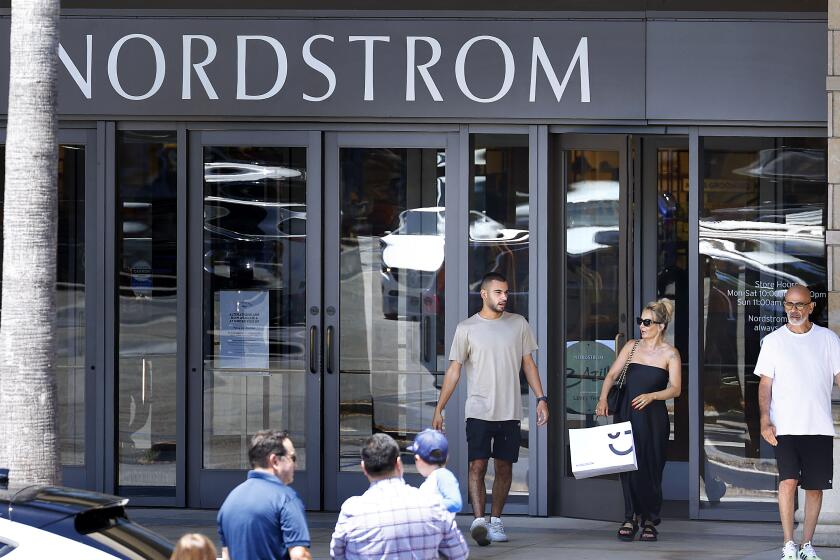Costco Sees Value in Higher Pay
- Share via
Much of corporate America is driven today by the belief that to be competitive, companies must cut their employees’ wages and benefits.
Nowhere is this creed held more devoutly than among the supermarket chains that are enduring a strike and have locked out their workers in Southern and Central California. A new kind of labor agreement that cuts pay and sharply slashes employer contributions to health benefits is imperative, declares Steven Burd, chief executive of Safeway Inc., “if we’re going to stay in business.”
Jim Sinegal sees things much differently.
The chief executive of Costco Wholesale Corp., a warehouse club retailer with 430 stores, likes to boast of his company’s relatively high pay and benefits for its 92,000 employees.
“We pay better than the supermarkets, and we pay much better than Wal-Mart,” Sinegal says. “That’s not altruism,” he continues. “It’s good business.”
The numbers seem to back him up. Costco’s labor costs amount to 7% of its $42 billion in annual sales, a key industry yardstick. By comparison, Wal-Mart Stores Inc.’s cost of labor stands at about 12% of its $244 billion in revenue, while the same figure for the supermarket firms comes in at about 16%.
How can Costco -- where a full-time clerk or warehouse worker earns more than $41,000 annually after four years, compared with $37,232 at the supermarkets -- pay more and have lower labor costs?
One factor is Costco’s warehouse format, which drives employee productivity.
Consider, for instance, the way it peddles peaches. Unlike supermarkets that carry a large variety of the fruit -- sliced, halved, diced -- Costco keeps things stunningly simple: It offers a No. 10 can of peaches for the restaurant trade and a six-pack of smaller cans for household customers. Says Chief Financial Officer Richard Galanti: “The savings on handling and inventory are sizable.”
Another big reason for Costco’s low labor expenses is that workers tend to stay with the company. Employee turnover, at less than 20%, is one-third the retail industry average.
And that kind of loyalty can mean big money. Roger Laverty, who once ran the Smart & Final Inc. chain and now heads Diedrich Coffee Inc. in Irvine, calculates that a 10% reduction in employee turnover can yield a 20% savings on labor costs.
At Costco, Laverty says, “they believe people are an asset of the company. They have an employee culture.”
Interestingly, 56 of Costco’s stores are unionized. The company picked up these outlets when it bought the Price Club chain in 1993. The workers there draw about the same paycheck as their nonunion counterparts, though their pensions are structured differently.
The company “pays well and the health plan is good,” says Rone Aloise of the Teamsters union. “The Costco agreement is probably the best as far as the retail industry goes.”
Unlike the supermarket workers, Costco employees have always paid a portion of their health insurance. The co-payment is now 4.5%, or $500 to $1,000 a year. That will rise to 8% in the next four years, to keep up with soaring insurance costs.
But the benefit package that Costco employees get in return is particularly rich. The company chips in $12,000 to $19,000 per employee (depending on whether they are full- or part-time). In the end, Costco’s contribution is at least a third higher than that made by supermarket employers to their workers’ health benefit plan.
Nor is Costco about to embrace another fad sweeping corporate America: offshoring. “We have a call-center operation here,” Sinegal says, gesturing across the firm’s Issaquah, Wash., headquarters complex. “We could move it to Bangladesh or somewhere. But what kind of a message would that send to our employees? Not a good one, I think.”
Costco doesn’t simply depend on happy workers for its success. It is so adroit at moving goods quickly that it often sells products before it has to pay suppliers for them.
“Sometimes we sell items twice before paying,” chortles Sinegal, who left San Diego State University to work for 19 years for Sol Price’s Fed-Mart and Price Club. He went on to found Costco in 1981 with Seattle entrepreneur Jeffrey Brotman, who is Costco’s chairman.
Growth has been rapid. A decade ago, Costco’s annual sales were $15 billion. This year, they could exceed $50 billion.
If Costco has a weak spot, it is on the bottom line. The company earns about 1.7 cents for each dollar of sales, compared with 2.5 cents or more for the supermarket chains and 3.5 cents for Wal-Mart.
Wall Street contends that one reason for this shoddy showing is Costco’s generosity to its employees. The stock, which closed Friday on Nasdaq at $37.61, is down sharply from more than $60 in 2000.
Costco executives dispute that enlightened labor practices are responsible for profit margins narrowing. Rather, they blame expansion into new markets in Texas, the Southeast and Midwest -- a situation that should improve with time.
Meanwhile, Costco has received a boost from the labor dispute at the California supermarkets. Galanti reckons that Costco is picking up an extra $40 million a month in sales because of the pickets in front of Ralphs, Albertsons, Vons and Pavilions stores.
Above all, as Costco executives have watched the turmoil at the grocery chains, they have been reminded about all that they are doing right.
“I don’t see what’s wrong,” Sinegal says, “with an employee earning enough to be able to buy a house or having a health plan for the family.
“We’re trying to build a company that will be here 50 years from now.”
*
James Flanigan can be reached at jim.flanigan@latimes.com.
More to Read
Inside the business of entertainment
The Wide Shot brings you news, analysis and insights on everything from streaming wars to production — and what it all means for the future.
You may occasionally receive promotional content from the Los Angeles Times.










